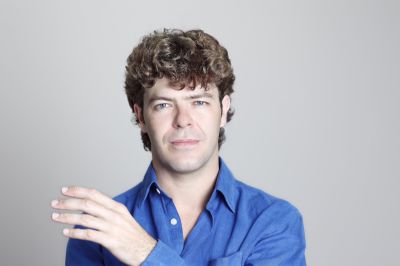|
Chamber
OAKMONT SEASON CLOSES WITH STRAUSS' PASSIONATE SONATA
by Terry McNeill
Thursday, April 11, 2024
Chamber
MORE GOLD THAN KORN AT ALEXANDER SQ CONCERT
by Terry McNeill
Sunday, April 7, 2024
Choral and Vocal
VIBRANT GOOD FRIDAY REQUIEM AT CHURCH OF THE ROSES
by Pamela Hicks Gailey
Friday, March 29, 2024
TWO OLD, TWO NEW AT THE SR SYMPHONY'S MARCH CONCERT IN WEILL
by Peter Lert
Saturday, March 23, 2024
Chamber
NOT A SEVENTH BUT A FIRST AT SPRING LAKE VILLAGE CONCERT
by Terry McNeill
Wednesday, March 20, 2024
THIRTY-THREE PLUS VARIATIONS AND AN OCEAN VIEW
by Terry McNeill
Saturday, March 16, 2024
Choral and Vocal
A ST. JOHN PASSION FOR THE AGES
by Abby Wasserman
Friday, March 8, 2024
Choral and Vocal
SPLENDID SCHUBERT SONGS IN SANET ALLEN RECITAL
by Terry McNeill
Saturday, March 2, 2024
Chamber
SHAW'S MICROFICTIONS HIGHLIGHTS MIRO QUARTET'S SEBASTOPOL CONCERT
by Peter Lert
Friday, March 1, 2024
Chamber
FRY ST. SQ PLAYS A DEMANDING 222 GALLERY CONCERT
by Terry McNeill
Friday, March 1, 2024
|
 |
 Conductor Pablo Heras-Casado |
LUMINOUS SOUND IN SF SYMPHONY WEILL HALL CONCERT
by Terry McNeill
Thursday, April 16, 2015
Though the Santa Rosa Symphony is the Green Music Center’s resident orchestra, when the San Francisco Symphony plays Weill Hall they take total artistic ownership. In the penultimate of the four annual Bay Area run outs the SFS played a compelling program April 16 of four masterworks with flawless cohesion and virtuosity.
Using a reduced-size orchestra of no percussion and just three cellos and two basses conductor Pablo Heras-Casado directed a taut and balanced Haydn Symphony No. 44 in E Minor. In a style opposite of conductors Michael Tilson Thomas and Bruno Ferrandis Ms. Heras-Casado gets results with no baton and little body movement. The Symphony flowed elegantly from hornist Robert Wards first bucolic notes to a Presto finale that had just a touch of menace. The conductor’s deft control and precise string playing made the 1771 Haydn a refined experience, and not at all the “mourning” of the sobriquet.
Mozart’s sparkling E-Flat Major Concerto, K. 271, closed the first half with Russian pianist Igor Levit the soloist. As with the Haydn all was in place, Mr. Levit choosing a crisp and direct approach with rapid right-hand scales and a tempo to match. There were piquant solos by oboist Mingjia Liu and before the cadenza (by Mozart) a lovely piano-horn duo. This was chaste playing with not a hint of bravado or shaky rhythms.
In the plaintive Andantino Mr. Levit continuously used the shift pedal to echo the orchestra’s introspective phrases and his expressive and even trills were nonpareil. The playing in the finale was at times dramatic but never loud with concertmaster Alexander Barantschik’s violin line in a lovely “question and answer” correspondence with the pianist. Mr. Levit’s detaché touch in scales was masterly, as was his cross-hand technique and subtle accents in ascending passagework. The short ersatz solo cadenza and the urbane conducting combined to produce an assured and luminous performance.
Beautiful playing continued after intermission with Debussy’s Prélude à après d’un Faune, and flutist Tim Day’s playing of the languorous opening solo was ravishing. Mr. Heras-Casado was in ho hurry with this enchanting music, letting long phrases unfold from the clarinet, harp and horn players. This work was recently played on the same stage by the Santa Rosa Symphony in a performance of equal weight and intensity, if not quite the precision of the San Francisco players.
A full orchestra compliment was marshaled for the evenings’ last work, Stravinsky’s Symphony in Three Movements. It was a savvy program choice as the 1945 work is a feast of orchestra color and tricky rhythms. Stravinsky’s music of this period, leading into the contemporary “Symphony of Psalms,” is instantly recognizable from the raucous but eminently controlled syncopation and instrumental execution. Section control is critical here and Mr. Heras-Casado kept distinct sectional sound, the sonorous harp, bassoon, clarinet and piano parts always clear. Even in the laconic Andante, a polar opposite to the histrionic first and third movements, the conductor never let the pace become flaccid.
The Con Moto finale grows without an initial pause into a high-stepping march with a persuasive fugue starting from Robin Sutherland’s piano part and moving to several potent climaxes. The ensemble was immaculate with a boisterous champagne orgy of sound, drawing the audience of 900 to a standing ovation.
Though not technically in residence the San Francisco Symphony has become one of Weill Hall’s musical treasures, easily equal in artistry to the recent Vienna Philharmonic, Russian National and Suisse Romande orchestra performances.
|

